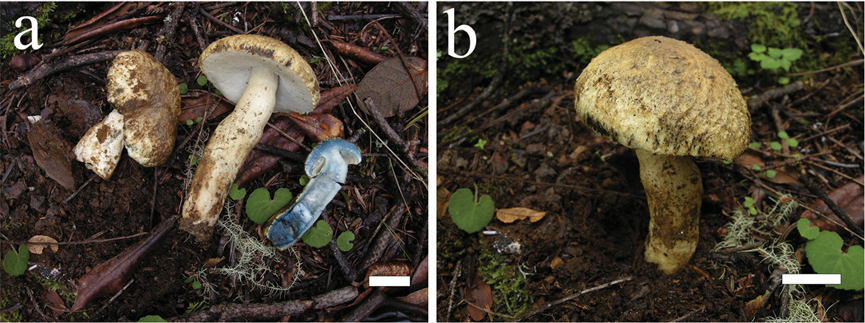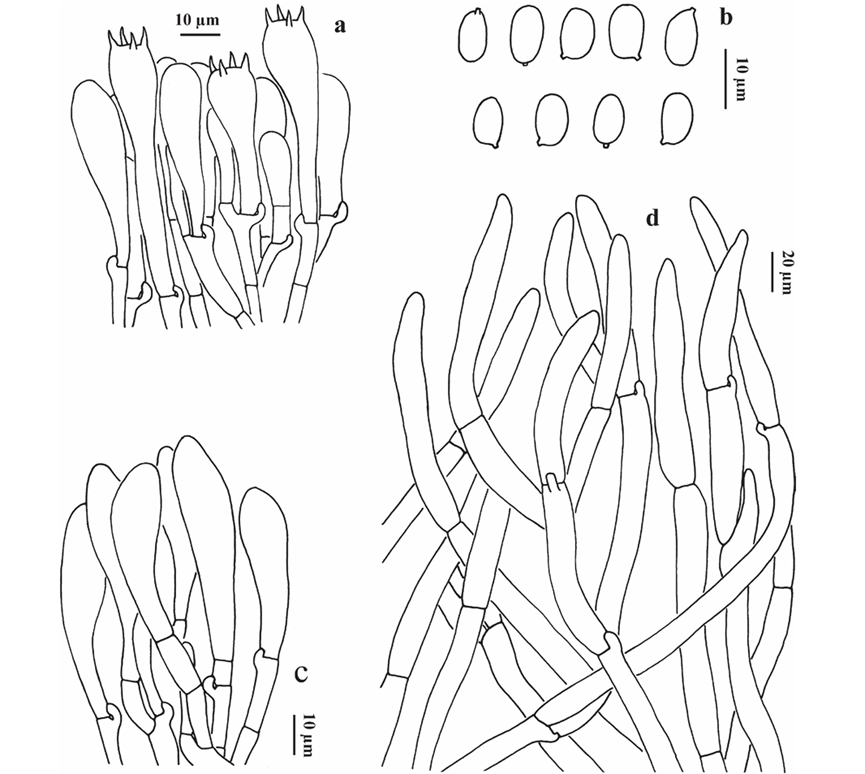 152
152
Gyroporus alpinus Yan C. Li, C. Huang & Zhu L. Yang, sp. nov.2021
MycoBank No: 838413
Holotype: China. Yunnan Province: Deqin, Shangri-La County, Haba Snow Moun tain, Yang Fang, alt. 3800 m, 14 Aug 2008, Y.C. Li 1478 (KUN-HKAS 56318, GenBank accession numbers: MW149435 and MW149438 for ITS, MW151268 and MW151269 for nrLSU, MW452609 and MW452610 for atp6).
Morphological description
Sexual morph: Pileus 3–6 cm in diam., sub-hemispherical to convex or plano-con vex, ivory yellow to greyish-yellow when young, grey-orange to brownish-yellow when mature; surface dry, densely covered with concolorous appressed scaly to floccose squamules, margin always incurved and slightly extended; context whitish, staining cerulean blue to dull blue when bruised. Hymenophore adnate when young, slightly depressed around apex of stipe when mature; surface white when young and then cream to yellowish when ma ture, staining dull blue when bruised; pores angular to roundish, fine, 2–3 per mm; tubes 3–8 mm long, whitish, staining dull blue when bruised. Stipe 6–8 × 1.8–2 cm, sub-cylindrical to clavate, white when young, yellowish-white to concolorous with pileal surface when mature; surface roughened, staining dull blue when bruised; context white to cream or yellowish, spongy when young and then hollow in age, staining cerulean blue to dull blue when bruised. Odour indistinct and taste mild.
Basidia 35–55 × 7–12 µm, clavate, 4-spored, hyaline in potassium hydroxide (KOH) and yellowish in Melzer’s Reagent. Basidiospores [60/3/2] (6.5) 7–10 × 5.5 7.5 (8.5) µm, [Q = 1–1.65 (1.72), Qm = 1.27 ± 0.23], smooth, ellipsoid to somewhat broadly ellipsoid, yellowish in KOH and primrose yellow in Melzer’s Reagent. Cheilo cystidia 30–60 × 8–14 µm, clavate to subfusiform, thin-walled, hyaline in KOH and yellowish to yellow in Melzer’s Reagent; Pleurocystidia not observed. Tube trama com posed of 6–11 µm wide interwoven hyphae, hyaline to yellowish in KOH, yellowish to brownish-yellow in Melzer’s Reagent. Squamules on pileus composed of 10–17 µm wide interwoven hyphae, hyaline to yellowish in KOH, yellowish to brownish-yellow in Melzer’s Reagent; terminal cells 80–120 × 12–17 µm, clavate to subcylindrical. Clamp connections frequently present in all tissues.
Asexual morph: Undetermined
Culture characteristics:
Habitat: Scattered on soil in alpine mixed forests dominated by Abies and Picea (Pinaceae) and Quercus (Fagaceae).
Distribution: Currently known from south western China.
GenBank Accession: ITS MW149435; LSU MW151268; atp6 MW452609
ITS MW149438; LSU MW151269; atp6 MW452610
Notes: Gyroporus alpinus is characterised by the initially ivory yellow to greyish yellow and then grey-orange to brownish-yellow pileus with scaly to floccose squam ules, the slightly extended pileal margin, the white pileal context staining cerulean blue to dull blue when bruised, the white to cream or yellowish hymenophore staining dull blue when bruised, the white to yellowish-white stipe, the spongy and then hollow context in the stipe, the frequent clamp connections in all tissues, the ellipsoid to some what broadly ellipsoid basidiospores and the distribution in alpine forests dominated by plants of the families Pinaceae and Fagaceae. In China, specimens of G. alpinus have been identified as G. cyanescens (Ying and Zang 1994; Zang 2013). Indeed, G. alpinus is closely related to G. cyanescens (Figs 1, 2). However, G. cyanescens, originally described from Europe, can be distinguished from G. alpinus by its relatively large basidiomata which are measuring 5.1–12.7 cm in diam., pale straw-coloured pileus, relatively nar row basidiospores measuring (7) 9–11 × 4.5–6 µm and distribution in forests domi nated by Pinus sylvestris or Fagus sylvatia (Fries 1821; Watling 1970; Vizzini et al. 2015).
In our analysis of the atp6 dataset, sequences of G. alpinus cluster together with sequences labelled as G. cyanescens from South Korea and Japan without statistical support (Fig. 1). Nagasawa (2001) treated the Japanese cyanescent taxon as G. cyanescens var. violaceotinctus Watling, because of the similar colours of their basidiomata and the similar-sized basidiospores. However, G. cyanescens var. violaceotinctus, originally described from Michigan, USA, is characterised by the white to tan context staining lilaceous and then indigo when bruised, the small basidia measuring 18–23.5 × 8–9 µm, the small cheilocystidia measuring 22.5 27.5 × 4.5–7.5 µm and the distribution in forests dominated by Acer (Aceraceae) and Betula (Betulaceae) (Watling 1969). These traits are greatly different from those of G. cyanescens and, therefore, Blanco-Dios (2018) treated G. cyanescens var. violaceotinctus as a novel species G. violaceotinctus (Watling) Blanco-Dios, while the Japanese taxon differs from G. violaceotinctus in its white context staining greyish blue at first and then blackish-blue when bruised without any lilaceous or violaceous tint, relatively large basidia measuring 24–42 × 9–11 µm, two types of cheilocystidia with the slender type measuring 30–64 × 6–12 µm and the voluminious type measuring 18–55 × 15–20 µm and distributions in mixed forest dominated by Fagus (Fagaceae), Quercus (Fagaceae), Betula (Betulaceae), Carpinus (Betulaceae) and Acer (Aceraceae) (Nagasawa 2001). The Chinese G. alpinus can be distinguished from G. violaceotinctus and the Japanese taxon by the dimensions of its basidiospores and basidia, morphology of cheilocystidia and host plants.
Gyroporus alpinus is phylogenetically related and morphologically similar to G. pseudocyanescens originally described from Spain in Crous et al. (2017) in our analy sis of the combined dataset (Fig. 2). However, G. pseudocyanescens has a strawish-cream to yellow cream and then more or less brownish to yellowish-brown pileus, a veluti nous pileal surface often cracking at maturity, relatively narrow basidiospores measur ing 8–11 × 4.5–6 (6.5) µm, short terminal cells of the hyphae on the surface of the pileus measuring 50–80 × 9–15 µm and a distribution in forests dominated by Pinus spp. or Quercus spp. (Crous et al. 2017).
Reference: [1] Huang, C. , Zhang, M. , Wu, X. , Wu, G. , Xu, J. , & Yang, Z. , et al. (2021). Cyanescentgyroporus(gyroporaceae, boletales) from china. MycoKeys, 81, 165-183.

Figure 3. a–c Gyroporus alpinus (KUN-HKAS 56318, type, photos by Y.C. Li) Scale bars: 2 cm. 
Figure 4. Microscopic features of G. alpinus (HKAS 56318, type) a basidia and cheilocystidium b basidiospores c cheilocystidia d pileipellis (squamules).

